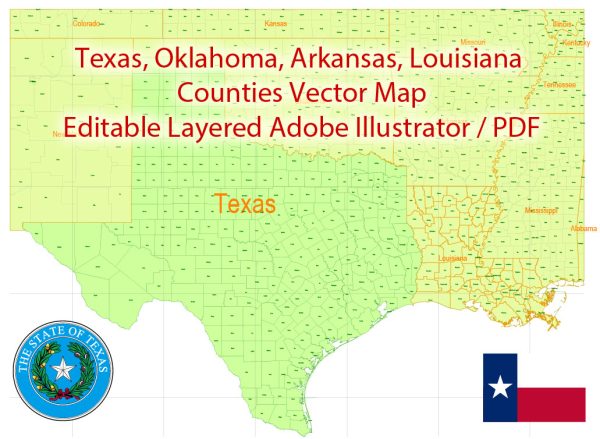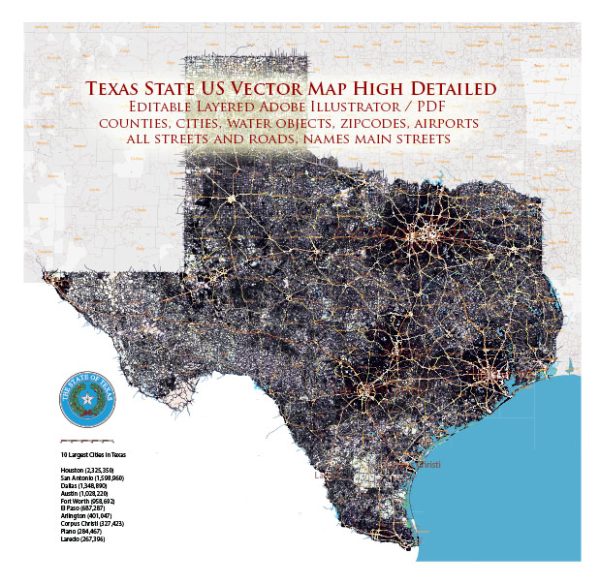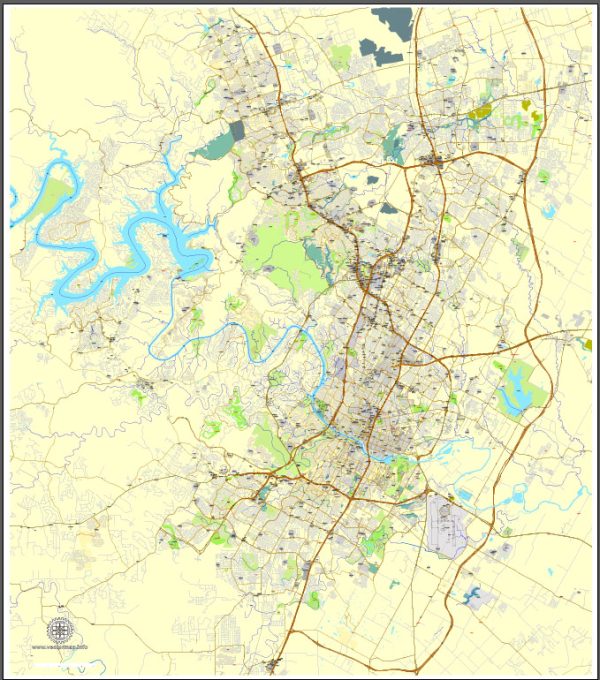About Austin vector map, Atlas 49 parts, Texas, USA
Archive size: 34 Mb
Content: Atlas 49 parts
We provide editable vector maps of Austin in different formats.
[Available in PDF and other formats: .DWG; .AI; .EPS; .CDR; .PPT.]
This vector maps show Austin city with all main streets, highways, airports, railways, power lines, rivers and other. Here below you can see a full list of features our vectorial Austin map has.
EN: The site shows a map of the *.AI format, if you need this map formats *.DWG, *.PDF, *.EPS, *.CDR, *.DXF, *.SHP, *.MIF and others – please advise us [contact] immediately prepare you the desired product and we will inform immediately.
ES: El sitio muestra un mapa del formato *.AI, si necesita esta formatos de mapas de *.DWG, *.PDF, *.EPS, *.CDR, *.DXF, *.SHP, *.MIF – por favor háganoslo saber [contact] de inmediato que preparar el producto deseado y le informaremos.
Austin, Texas, USA.
This vector map of Austin city is used as a basis for design, editing, and further printing.
This is the most detailed, exact map of Austin city for high-quality printing and polygraphy. You can always clarify the map development date by contacting us.
For your convenience, all objects on Austin vector city map are divided into layers. And the editing is very easy – colors, lines, etc.
You can easily add any objects needed (e.g. shops, salons, sale points, gas station or attraction) on any layer of Austin vector map.
One of the advantages of Austin city vector maps of our production is the relevance of cartographic data, we constantly update all our products.
This vector map of Austin city is used by:
designers, layout designers, printers, advertisers and architects. Our product – vector maps – is designed for further editing and printing in large formats – from @Wall format (a few meters) to A-0 and A-1, A-2, A-3.
The Austin city map in vector format is used for design, urban planning, presentations and media visualizations.
Austin is the capital of the U.S. state of Texas and the seat of Travis County, with portions extending into Hays and Williamson counties. It is the 11th-most populous city in the United States and the 4th-most populous city in Texas. It is also the fastest growing large city in the United States, the second most populous state capital after Phoenix, Arizona, and the southernmost state capital in the contiguous United States. As of the U.S. Census Bureau’s July 1, 2017 estimate, Austin had a population of 950,715 up from 790,491 at the 2010 census. The city is the cultural and economic center of the Austin–Round Rock metropolitan statistical area, which had an estimated population of 2,056,405 as of July 1, 2016. Located in Central Texas within the greater Texas Hill Country, it is home to numerous lakes, rivers, and waterways, including Lady Bird Lake and Lake Travis on the Colorado River, Barton Springs, McKinney Falls, and Lake Walter E. Long.
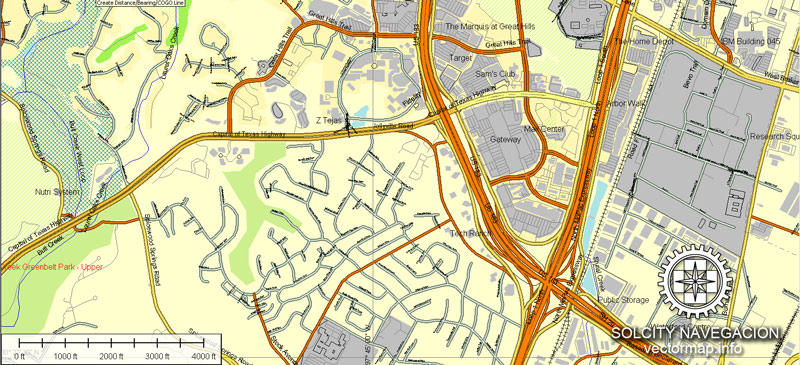
The advertising and presentation map of Austin city (usually the final designer marks the routes, and puts the client’s objects (shops, saloons, gas stations etc.)
The undoubted advantage is that people will NEVER throw out this advertising product – the map. In fact, as an advertising medium, a city map is the most “long-playing” of the well-known polygraphic advertising media, with the longest lifespan, and the maximum number of interactions with the customer.
For travelers, maps are sold at the airports and gas stations around the world. Often the source is our vector maps.
Take a look, who purchases our vector maps of Austin city in “Our Clients and Friends” page – these are large and small companies, from super-brands like Volvo and Starbucks, to small design studios and printing houses.
It’s very easy to work with vector maps of Austin city, even for a not very experienced designer who can turn on and off the map layers, add new objects, change the colors of fill and lines according to customer requirements.
In the 1830s, pioneers began to settle the area in central Austin along the Colorado River. In 1839, the site was chosen to replace Houston as the capital of the Republic of Texas and was incorporated under the name “Waterloo”. Shortly afterward, the name was changed to Austin in honor of Stephen F. Austin, the “Father of Texas” and the republic’s first secretary of state. The city grew throughout the 19th century and became a center for government and education with the construction of the Texas State Capitol and the University of Texas at Austin. After a severe lull in economic growth from the Great Depression, Austin resumed its steady development, and by the 1990s it emerged as a center for technology and business. A number of Fortune 500 companies have headquarters or regional offices in Austin including, 3M, Amazon.com, Apple Inc., Cisco, eBay, General Motors, Google, IBM, Intel, Oracle Corporation, Paypal, Texas Instruments, and Whole Foods Market. Dell’s worldwide headquarters is located in nearby Round Rock, a suburb of Austin.
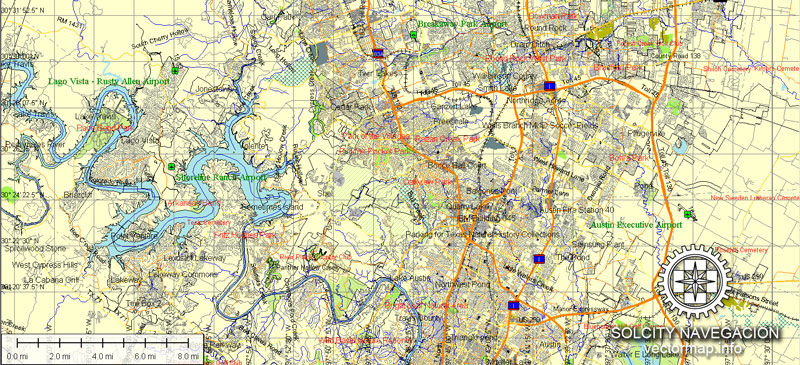
The undoubted advantage of Austin city vector maps in printing is an excellent and detailed visualization, when customer can expand a large paper map and instantly define his location, find a landmark, an object or address on map, unlike using the popular electronic formats of Google and Yandex maps for example.
Printable vector maps of Austin city are much more convenient and efficient than any electronic maps on your smartphone, because ALL DETAILS are displayed in the entire space of Austin city map.
Useful tips on working with vector maps of cities and countries in Adobe Illustrator.
«V» – launches the Selection tool (cursor, black arrow), which makes active any vector line.
«А» – launches the Direct Selection tool (white cursor), allows you to select curve elements and drag them to the desired place.
«R» – activates the Rotate tool, which helps you rotating selected objects around the center point by 360 degrees.
«E» – gives you the opportunity to use the Eraser tool and erase unnecessary parts.
«X» – switches between Fill and Stroke in the Tools section. Try to get used to this hot key and
you will quickly understand that you can’t live and work without it.
Guides are not limited to vertical and horizontal in Adobe Illustrator. You can also create a diagonal guide for example. Moreover, you can turn any contours into guides. Select the outline and go to View > Guides > Make Guides (Create Guides), or simply press Cmd/Ctrl + 5. You can also turn the guides back into an editable object. Go to menu, View > Guides > Unlock Guides (Release Guides), select the guide you want to edit and select View > Guides > Release Guides (Reset Guides), or just press Cmd/Ctrl + Option / Alt + 5).
Residents of Austin are known as Austinites. They include a diverse mix of government employees, college students, musicians, high-tech workers, blue-collar workers, and a vibrant LGBT community. The city’s official slogan promotes Austin as “The Live Music Capital of the World”, a reference to the city’s many musicians and live music venues, as well as the long-running PBS TV concert series Austin City Limits. The city also adopted “Silicon Hills” as a nickname in the 1990s due to a rapid influx of technology and development companies. In recent years, some Austinites have adopted the unofficial slogan “Keep Austin Weird”, which refers to the desire to protect small, unique, and local businesses from being overrun by large corporations. In the late 19th century, Austin was known as the “City of the Violet Crown”, because of the colorful glow of light across the hills just after sunset. Even today, many Austin businesses use the term “Violet Crown” in their name. Austin is known as a “clean-air city” for its stringent no-smoking ordinances that apply to all public places and buildings, including restaurants and bars.
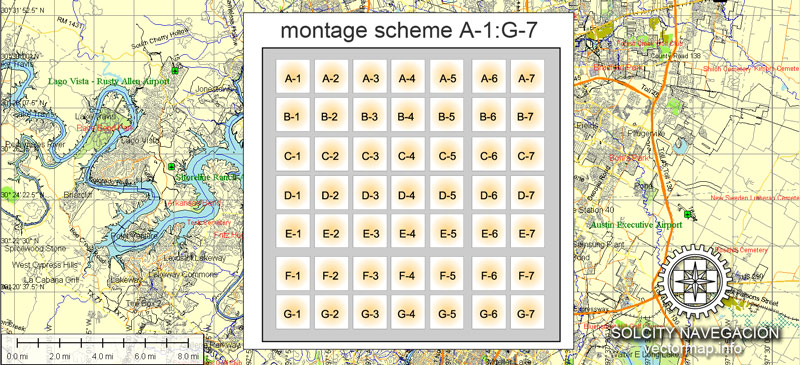
You will probably want to change the color scheme used on our Austin vector city map.
To quickly and effectively play with colors.
Of course, you can do it manually, all objects in our Austin city vector map are divided according to types and layers, and you can easily change the color gamma of vector objects in groups and layers.
But there is more effective way of working with the whole VECTOR MAP of Austin city and all layers:
The overview dialog «Edit colors»/«Repaint Graphic Object» (this dialog box name can change depending on the context):
If you have selected a part or a layer of Austin city vector map and open the dialog box by clicking the icon in the Control panel, on the Samples palette or the Color Catalog, or if you choose Edit > Edit Colors> Repaint Graphic Object, then the «Repaint Graphic Object» dialog box appears, and you get access to «Assign» and «Edit» tabs.
If a picture or a map fragment is not selected, and you open the dialog box by clicking the icon in the Control panel, on the Samples palette or in the Color Catalog, the «Edit Colors» dialog box appears and you can only access the «Edit» tab.
U.S. News & World Report named Austin the #1 place to live in the U.S. for 2017 and 2018. In 2016, Forbes ranked Austin #1 on its “Cities of the Future” list, then in 2017 placed the city at that same position on its list for the “Next Biggest Boom Town in the U.S.” Also in 2017, Forbes awarded the South River City neighborhood of Austin its #2 ranking for “Best Cities and Neighborhoods for Millennials”. WalletHub named Austin the #6 best place in the country to live for 2017. The FBI ranked Austin as the #2 safest major city in the U.S. for 2012.
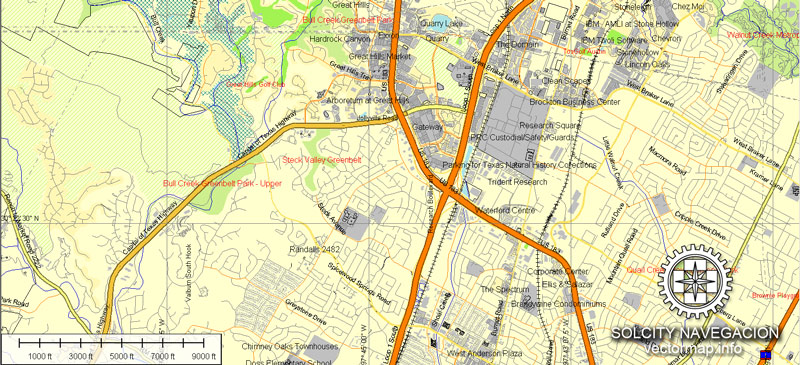
Regardless of the name at the top of the dialog box, the right-hand side always displays the color group of the current document, as well as two default color groups: Print Color and Grayscale. These color groups can be selected and used any time.
Create and edit color groups of Austin city vector map, and also assign colors using the «Edit Colors»/ а «Repaint Graphic Object» dialog box.
A. Creating and editing of a color group on the «Edit» tab
B. Assigning colors on the «Assign» tab
C. Select a group of colors from the «Color groups» list
The option «Repaint a graphic object» in the lower part of the dialog box allows you to preview the colors on a selected layer of Vector map, or a group of elements, and specify whether its colors will be redefined when the dialog box is closed.
The main areas of the dialog box are:
«Edit»
The «Edit» tab is designed to create a new or edit the existing color groups.
The harmony rules Menu and the Color Wheel are used to conduct experiments with color harmonies. The color wheel shows how colors are related in color harmony, and the color bars allow you to view and manipulate an individual color values. In addition, you can adjust the brightness, add and remove colors, save color groups and view colors on the selected Vector Map of Austin city or a separated layers.
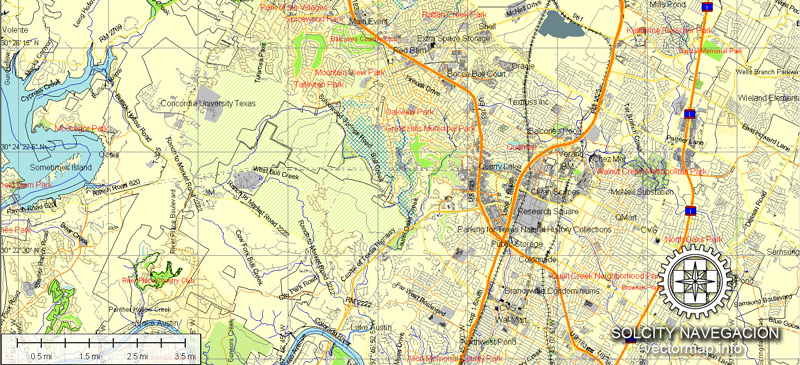
«Assign»
The «Assign» tab is used to view and control on how the original colors are replaced with colors from the color group like your corporate colors in the Vector Map of Austin city.
The assign color ability is provided only if the entire map, layer or fragment is selected in the document. You can specify which of new colors replace the current colors, whether the spot colors should be preserved and how colors are replaced (for example, you can replace colors completely or changing the color tone while maintaining the brightness). The «Assign» tab allows you to redefine colors in the Vector Map of Austin city, or in separate layers and fragments using the current color group or reducing the number of colors in the current Vector Map.
Color groups
Is a list of all saved color groups for current document (the same groups appear in the «Samples» palette). You can edit and delete the existing color groups, as well as creating a new ones using the list of “Color Groups” in the dialog box. All changes appear in the «Samples» palette.
The highlighted color group shows, which color group is currently edited.
Any color group can be selected and edited, or used to redefine the colors in the selected vector map of Austin city, its fragments or elements.
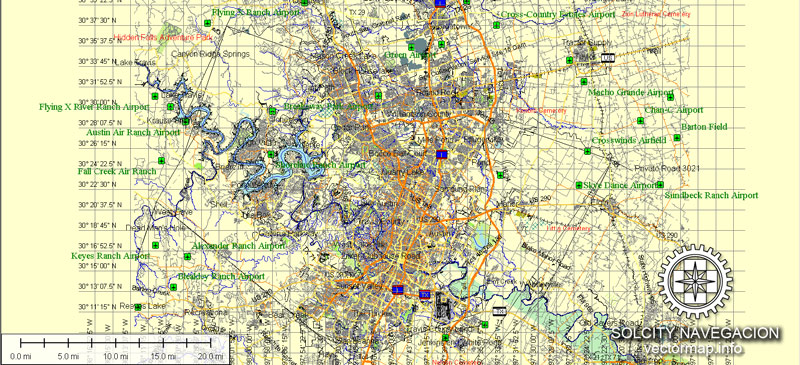
Saving a color group adds this group to the specified list.
Opening the «Edit Colors»/«Repaint Graphic Object» dialog box.
Open the «Edit Colors»/«Repaint Graphic Object» dialog box using one of the following methods:
«Edit»> «Edit Colors»> «Repaint Graphic object» or «Repaint With Style».
Use these commands if you need to edit the colors in the selected vector map of Austin city.
«Repaint Graphic object» button on the «Control» panel.
Use this button if you need to adjust colors of Austin city vector map using the а «Repaint graphic object» dialog box.
The specified button is available if the selected vector map or its fragment contains two or more colors.
Note. This color editing method is convenient for global color adjustment in a vector map, if global colors were not used when creating a City Map of Austin.
The «Edit colors» button or «Edit or apply colors» on the «Color Catalog» palette
Click this button if you need to edit colors on the «Color Catalog» palette or edit and then apply them to the selected Vector Map of Austin city or its fragment.
The «Edit color group» button or «Edit or apply color group» on the «Samples» palette.
Click this button if you need to edit the colors in the specific color group or edit and apply them to the selected Vector Map of Austin city or a group of its elements, for example, the whole layer “Streets and lines”. You can also double-click the color group in the Samples panel to open the dialog box.

If the map file is too large and your computer freezes or even can’t open it quickly:
1. Try to reduce the color resolution of the video card (display) to 256 colors while working with a large map.
2. Using Windows Task Manager, select all the application you don’t need, while working with map, just turn them off.
3. Launch Adobe Illustrator. (DO NOT OPEN the vector map file)
4. Start the Windows Task Manager using administrator rights > Find the “Illustrator” process > set the «real time» priority,
5. Open the file. When you see the LEGACY FONT popup window – click “OK” (do not update). You can restore the TEXT later.
6. Can also be useful: When file is opened – Edit > Settings > Basic Settings > disable smoothing. /// It looks scary, but works quickly)))
We recommend saving the file in Adobe Illustrator 10 version. It’s much more stable when working with VERY BIG size files.
Our printable maps of Austin are full editable and ready for printing. You can change style or fonts, add images, or change the color scheme. Our vector maps can be adjusted to any necessary size, no matter what big it is.
Austin vectorial map features:
Highways with names,
Major streets with names,
Major Roads,
Minor Roads,
Private Roads,
Latitude and Longitude data,
Lake, ponds and other water bodies,
Landmark fill,
Cemeteries,
County Borders with fill,
National Park Borders,
Airports
Houses,
Big and small Rivers, small streams also,
Railway lines with stops,
Recreation zones,
Parking,
Sidewalk/Walkway/Pedestrian roads,
Power Lines,
Dam,
Pipeline,
Parks.
Need some specific POI (points of interest like stores and shops for example) to be displayed on our layered vector maps of Austin? Please feel free to contact us.
Cities and counties near Austin city vector map
AI vector map of Austin also includes maps of (please see the preview): Brenham, Katy, Rosenberg, Pecan Grove, Richmond, Mission Bend, Wharton, Sugar Land, Tomball, Stafford, Missouri City, El Campo, Bellaire, West University Place, The Woodlands, Jollyville, Anderson Mill, Pflugerville, Lakeway, Cedar Park, Round Rock, Kyle, Leander, Georgetown, Lockhart, Taylor, San Marcos, Canyon Lake, New Braunfels, Seguin, Bee Cave, Hornsby Bend, West Lake Hills, Briarcliff, Jonestown, Jollyvile, Dessau, Brushy Creek.
Purchasing of Adobe Illustrator map of Austin city
This purchase has a Royalty Free license, which means you don`t have to pay an extra cost for more copies. You can edit, copy, print as many times as you need.
If you need a specific vector map of the city we don`t have – feel free to write us and we will prepare it as soon as possible: secreto@solcity.info
We always have unbeatable prices and quality. VectorMap.info
See more United States (USA) cities street map in vector
For example: Vector Map Albuquerque, New Mexico, US
Allentown, Pennsylvania, Printable Map, US
Vector Map Atlanta, Georgia, US
PDF Map Austin, Texas, US
Austin is the capital of the U.S. state of Texas and the seat of Travis County. It is the 11th-most populated city in the U.S and the 4th-most populated in Texas. It is the fastest growing of the 50 largest US cities and the second largest state capital city in the United States cities street maps after Phoenix, Arizona. As of June 1, 2016, Austin had a population of 931,830 (U.S. Census Bureau estimate). Located in Central Texas in the foothills of Texas Hill Country, the city is home to numerous lakes, rivers, and waterways including Lady Bird Lake, Barton Springs, McKinney Falls, the Colorado River, Lake Travis, and Lake Walter E. Long. It is the cultural and economic center of the Austin–Round Rock metropolitan area, which had an estimated population of 2,010,860 as of June 1, 2016.
In the 1830s, pioneers began to settle the area in central Austin along the Colorado River. In 1839, the site was officially chosen to replace Houston as the new capital of the Republic of Texas and was incorporated under the name “Waterloo.” Shortly thereafter, the name was changed to “Austin” in honor of Stephen F. Austin, the “Father of Texas” and the republic’s first secretary of state. The city subsequently grew throughout the 19th century and became a center for government and education with the construction of the Texas State Capitol and the University of Texas at Austin. After a lull in growth from the Great Depression, Austin resumed its development into a major city and, by the 1980s, it emerged as a center for technology and business. A number of Fortune 500 companies have headquarters or regional offices in Austin, including Apple Inc., Cisco, eBay, Google, IBM, Intel, Oracle Corporation, Texas Instruments, 3M, and Whole Foods Market. Dell’s worldwide headquarters is located in nearby Round Rock, a suburb of Austin.
Residents of Austin are known as Austinites. They include a diverse mix of government employees, college students, musicians, high-tech workers, blue-collar workers, a vibrant LGBT Community The city’s official slogan promotes Austin printable map as “The Live Music Capital of the World,” a reference to the many musicians and live music venues within the city, as well as the long-running PBS TV concert series Austin City Limits. The city also adopted “Silicon Hills” as a nickname in the 1990s due to a rapid influx of technology and development companies. In recent years, some Austinites have also adopted the unofficial slogan “Keep Austin Weird,” which refers to the desire to protect small, unique, and local businesses from being overrun by large corporations. In the late 1800s, Austin was known as the “City of the Violet Crown” because of the colorful glow of light across the hills just after sunset. Even today, many Austin vector map businesses use the term “Violet Crown” in their name. Austin is known as a “clean-air city” for its stringent no-smoking ordinances that apply to all public places and buildings, including restaurants and bars. The FBI ranked Austin as the second-safest major city in the U.S. for the year 2012.
Geography of Austin, Texas
The most southerly of the capitals of the contiguous forty-eight states, Austin is located in Central Texas, along the Balcones Escarpment and Interstate 35, 150 miles northwest of Houston. It is also 160 miles south of Dallas and 75 miles north of San Antonio. Its elevation varies from 425 feet (130 m) to approximately 1,000 feet (305 m) above sea level. In 2010, the city occupied a total area of 271.8 square miles (704 km2). Approximately 6.9 square miles (18 km2) of this area is water.
Austin is situated on the Colorado River, with three man-made (artificial) lakes within the city limits: Lady Bird Lake (formerly known as Town Lake), Lake Austin (both created by dams along the Colorado River), and Lake Walter E. Long that is partly used for cooling water for the Decker Power Plant. Mansfield Dam and the foot of Lake Travis are located within the city’s limits. Lady Bird Lake, Lake Austin, and Lake Travis are each on the Colorado River. As a result of its straddling the Balcones Fault, much of the eastern part of the city is flat, with heavy clay and loam soils, whereas, the western part and western suburbs consist of rolling hills on the edge of the Texas Hill Country. Because the hills to the west are primarily limestone rock with a thin covering of topsoil, portions of the city are frequently subjected to flash floods from the runoff caused by thunderstorms. To help control this runoff and to generate hydroelectric power, the Lower Colorado River Authority operates a series of dams that form the Texas Highland Lakes. The lakes also provide venues for boating, swimming, and other forms of recreation within several parks on the lake shores.
Austin is located at the intersection of four major ecological regions, and is consequently a temperate-to-hot green oasis with a highly variable climate having some characteristics of the desert, the tropics, and a wetter climate. The area is very diverse ecologically and biologically, and is home to a variety of animals and plants. Notably, the area is home to many types of wildflowers that blossom throughout the year but especially in the spring, including the popular bluebonnets, some planted in an effort by “Lady Bird” Johnson, wife of former President Lyndon Johnson.
A popular point of prominence in Austin is Mount Bonnell. At about 780 feet (238 m) above sea level, it is a natural limestone formation overlooking Lake Austin on the Colorado River, with an observation deck about 200 feet (61 m) below its summit.
The soils of Austin range from shallow, gravelly clay loams over limestone in the western outskirts to deep, fine sandy loams, silty clay loams, silty clays or clays in the city’s eastern part. Some of the clays have pronounced shrink-swell properties and are difficult to work under most moisture conditions. Many of Austin’s soils, especially the clay-rich types, are slightly to moderately alkaline and have free calcium carbonate.
Austin has several rock climbing locations. Rock climbing can be found at three Austin parks on editable map: Barton Creek Greenbelt, Bull Creek Park and McKinney Falls State Park. The sport-climbing routes at Barton Creek Greenbelt–with its many vertical to overhanging walls–offer challenges to both the beginner and advanced climber.
Source
Check also a free vector maps we have:
+Vector map of USA, printable and editable
Author Rating
Aggregate Rating
no rating based on 0 votes
@vectormapper
Product Name Austin Map Vector Texas printable Atlas 49 parts vector street map editable Adobe Illustrator City Plan
Price
USD 35
Product Availability
Available in Stock

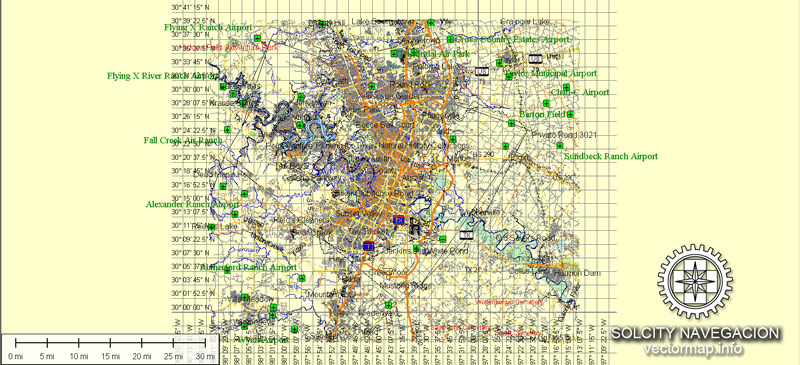









 Author: Kirill Shrayber, Ph.D.
Author: Kirill Shrayber, Ph.D.